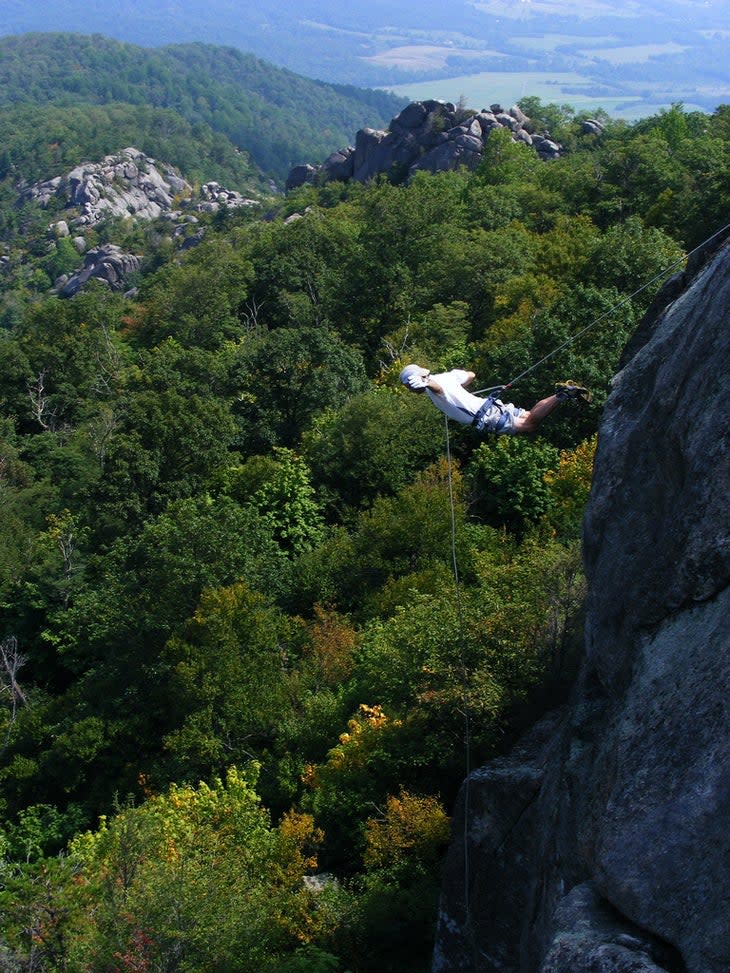Rappellers Threw Themselves Face First Off Cliff With One-Nut Anchor
This article originally appeared on Climbing
Two guys turned up at the cliff one day. They placed one wire at the top of an overhung, 100-foot face, then threw themselves off it into face-first rappels. We politely asked if they planned to put another piece in their anchor, and they said, "No. That's not going anywhere."--Matt, via Climbing.com
LESSON: Unless these guys were an Australian special forces unit, storming your crag, this is a bad idea for many reasons. One of the primary criteria for anchor building is that it should be redundant. A single nut is perfectly capable of holding a body weight rappel under ideal conditions, but ideal conditions aren't something you can plan for. Rock can break. Nuts can slip. It's best to shoot for three pieces of solid gear in case anything goes wrong with one, or two. This also violates another primary rule of anchor building: it should be strong. Try to have all of your pieces add up to at least 28 kn. This makes your rope the weakest link in the system, and rope breaks are pretty rare under best practices. The largest nuts are usually only rated to around 10 kn.
As for the face-first rappel (commonly called an Australian-style rappel), they make descents a lot more dangerous. An Aussie rappel requires you to run your rope through a rappel device on the back of your harness. Most harnesses don't have load-bearing loops on the back. Even if your harness does (or you wear you harness backwards), Aussie rappels still involve setting up a system that you trust your life to behind your back, where it's hard to see. Safest option: traditional rappel, extended and backed up with a friction hitch.

Photo: scrappapervlog/flickr; http://ow.ly/ymsp7
At Horseshoe Canyon Ranch, I overheard a belayer teaching his climber how to clean a sport anchor from the ground. It went something like this: “Now make sure you’re on the ledge, standing on good feet, and you can reach the anchor.” “OK. I’m there.” “Great. Now unclip the slings from your harness and clip them to the anchor.” “OK.” “I’m giving you slack--you good?” “I’m good.” “OK. Now untie the rope from your harness.” At that point I intervened and asked if she'd weight-tested her connection. He gave me an irritated look and shouted, "Sit back on your slings first to show me you’re on the anchor." As she leaned back, she started to fall off her ledge, screamed, and grabbed the rock. She had clipped her slings to the rope between the draws, not the bolts or chains. The belayer's expression was equal parts terror and relief. He looked back at me and mouthed, “Thank you!”--Submitted by Drew, via Climbing.com
LESSON: Climbing isn’t a sport where you should learn systems on-the-fly. Cleaning an anchor for the first time can be scary, so it’s easy to make mistakes. The bottom line is that you’re alone when you get to the anchor; your partner can’t visually assess what your doing. That’s why you should practice on the ground until you have it dialed before taking it up on the wall. Also, whether you’re going in direct or getting on rappel, sit back and test the connection first. Make sure you’re on before removing your previous connection.
This guy was climbing a long sport route. It usually requires you to be lowered twice to reach the ground. He thought he could do it in one. Without knotting the end of the rope, he tried, but realized he wasn't going to make it during his descent. Instead of moving to the second anchor, he made his belayer climb 20 feet up the wall so he could get down.--Submitted by Lisa, via email
LESSON: There's a little problem here. If you get stuck 20-feet off the deck and make your belayer climb 20-feet to get you down, you've now got a belayer stuck 20-feet off the deck. You can yo-yo back and forth until you're both 10-feet off the deck, but there's no way to get both of you on the ground while safely roped-in. A better option would have been to use that second anchor after realizing there was a problem. The best option would have been to know how long the route was and have a plan for getting down before starting. Read a guidebook. Get beta from Mountain Project. Do your research. Also, always knot the end of your rope! It's so simple, and would prevent so many accidents.
Want more? Check out more installments in our ever-growing hall of dangerous behavior:
Climbed On Webbing Instead of Rope
Used Hands for Belay ... No Device
Actually used a Grappling Hook for Climbing
Belay Device Somehow Unclipped Itself, And Leader Fell
They Used Parachute Cord For Slings
No belay Anchor on Multi Pitch, and Leader Falls
Lucky He Didn't Die. Lowered From a Toy Carabiner
Unfortunate Groundfall, Fortunate Landing
Leader Decks When Experienced Climber Bungles the Belay
Saw Through Someone Else's Rope
Belayed With Hands Only--No Device!
Smoke Brick Weed and Go Climbing
Belay With a Knife In Your Hand
Don't Let a Clueless Dad Take a Kid Climbing
She Got Frustrated and Untied--On Lead
For exclusive access to all of our fitness, gear, adventure, and travel stories, plus discounts on trips, events, and gear, sign up for Outside+ today.

